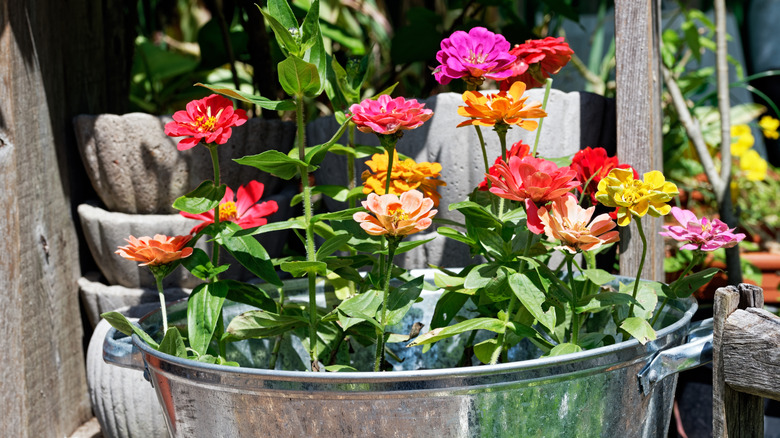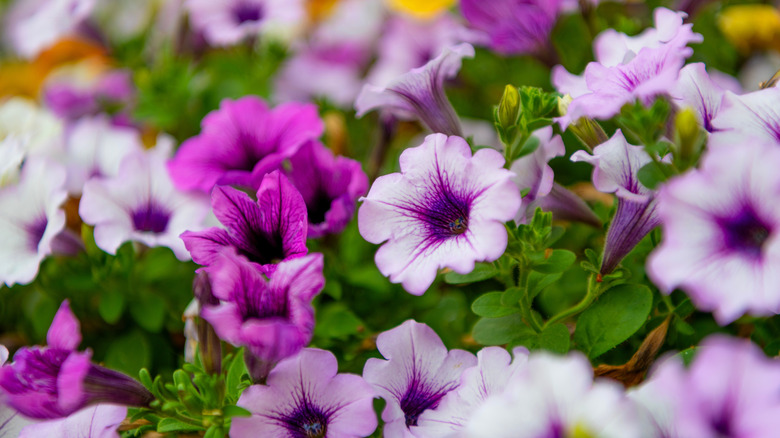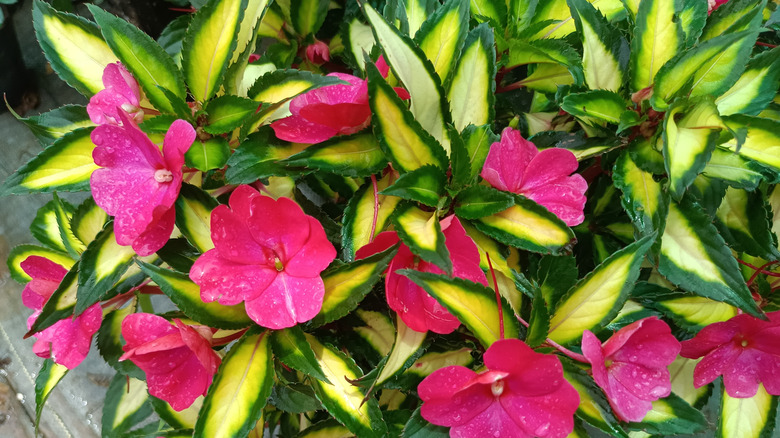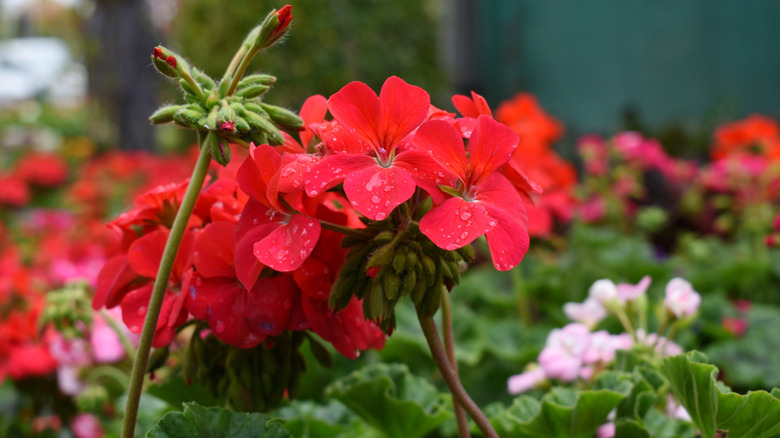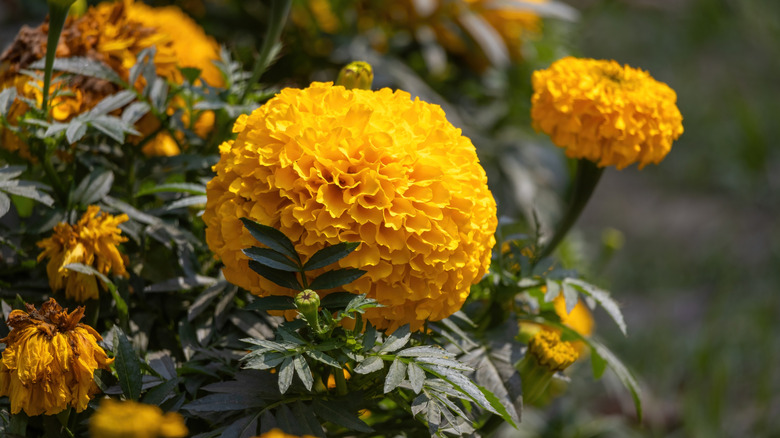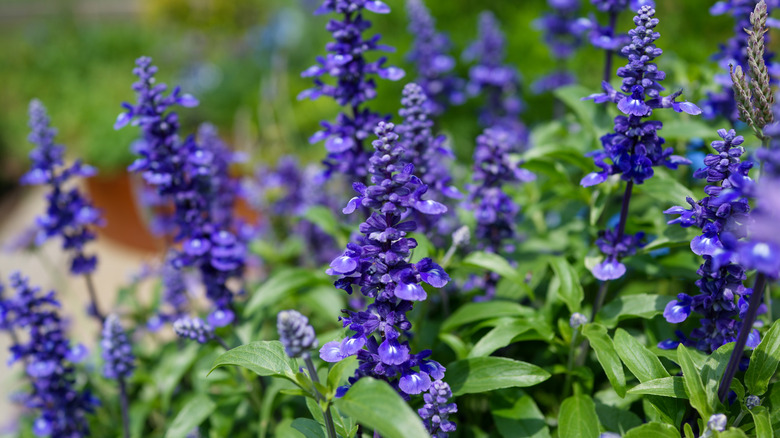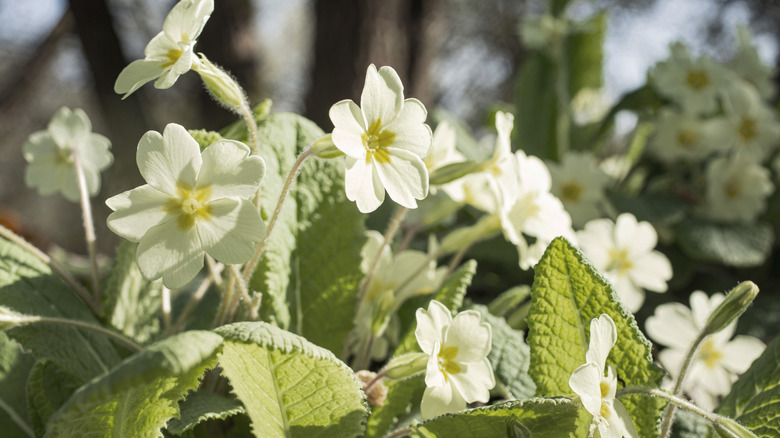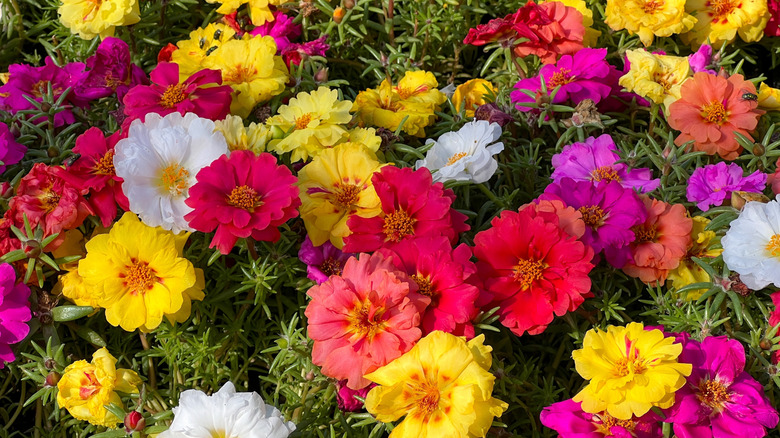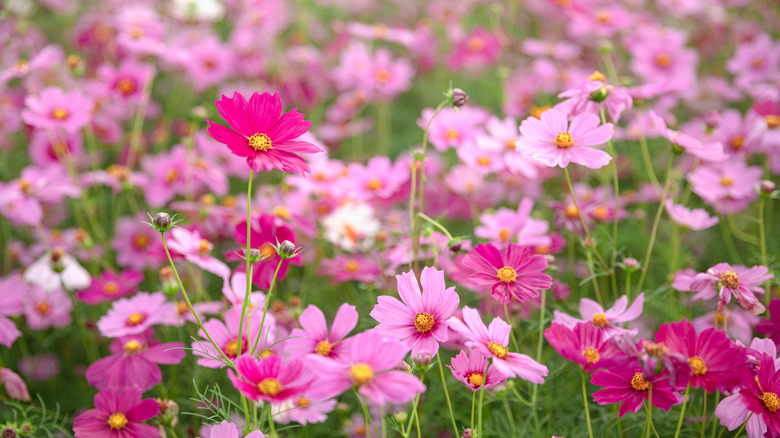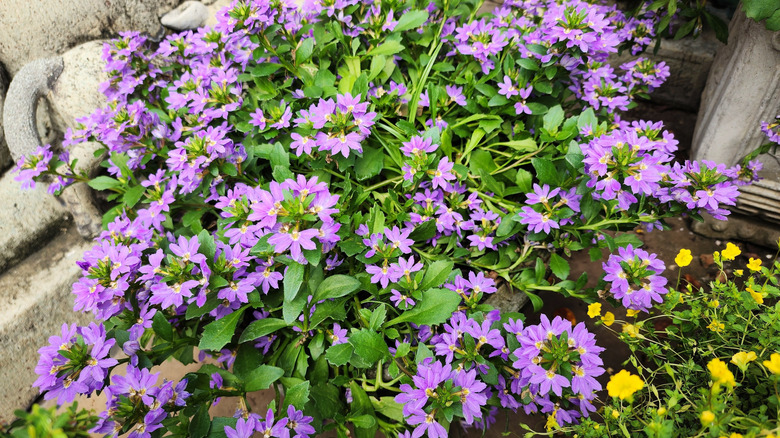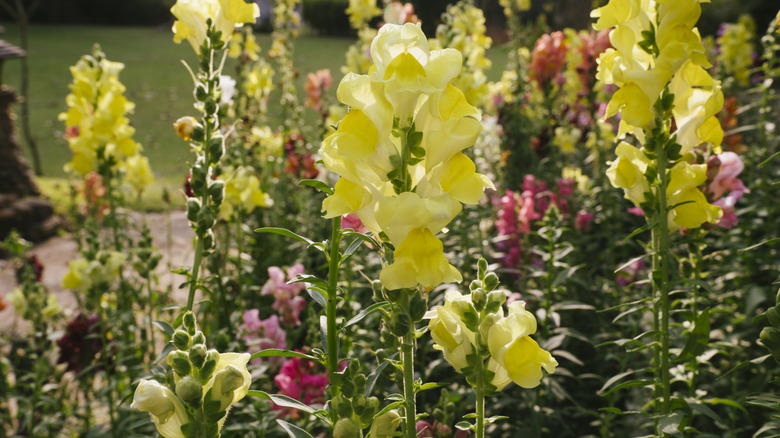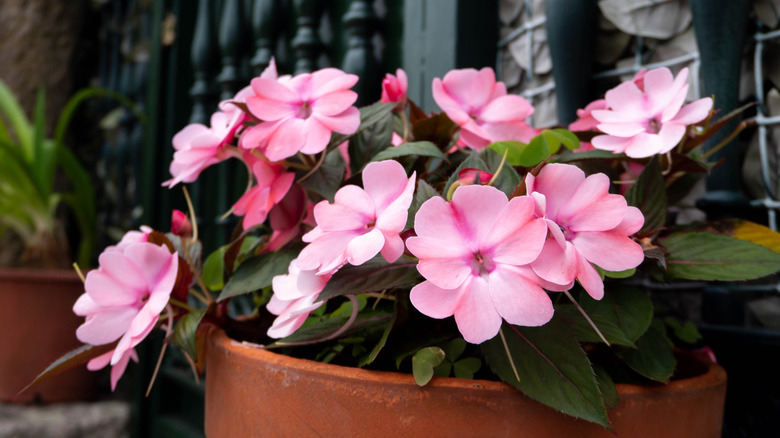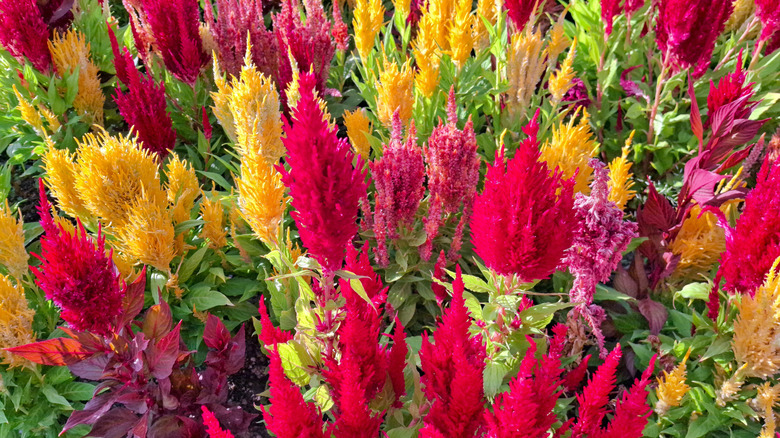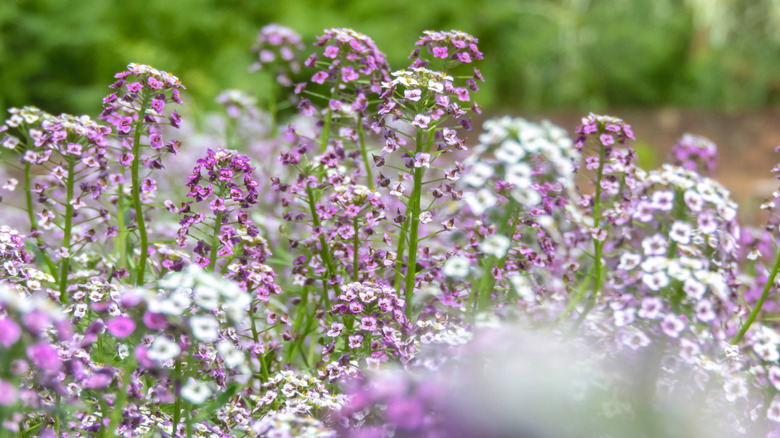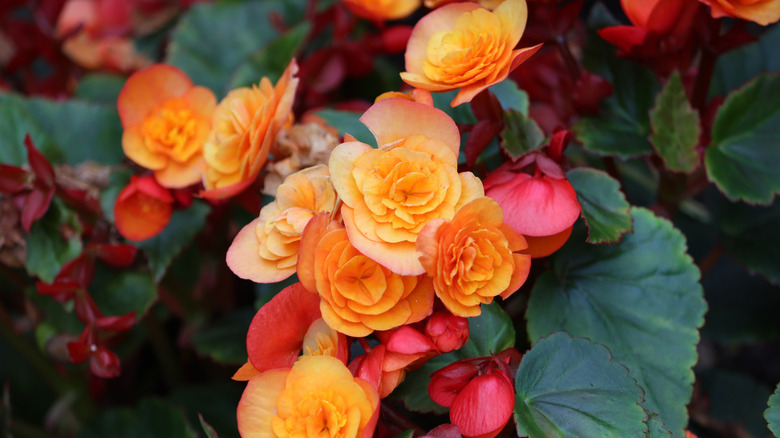16 Summer Blooming Annual Flowers That Can Take The Summer Heat
When you crave color and beauty on your patio or in your garden all summer long, it's important to choose carefully which flowers you'll use. Summer-blooming annuals are a great option if you want to have lush blooms without the higher cost of perennials. While they don't return year after year, they're easy to work with while being budget-friendly. Many are even flowers that attract pollinators, helping ensure you have a lively garden of butterflies and bees, as well as hummingbirds. You can find them at most garden centers or nurseries. Just ensure you choose options that work best with your climate, as some plants may prefer morning sun while others simply thrive in hot, humid weather.
Whether grown in a container, hanging basket, or bed, this diverse collection of summer-blooming annuals that can tolerate the heat encompasses species of varying sizes and hues. Preferences for the soil and acidity vary by species, so always read the care instructions for the healthiest plant. You should typically water your annuals daily, unless otherwise stated. If unsure about whether you should water, look for signs of thirst, such as your plant turning pale or wilting. When watering, do so in the morning hours to avoid evaporation under the summer sun. General care tips out of the way, here's a rich selection of annuals that will bloom all summer long.
The wide variety of zinnias is perfect for bright colors
Starting with zinnias (Zinnia spp.), these plants are good for beginners and can tolerate sizzling summer temps. They require at least six hours of sun daily, and bloom throughout the summer in an array of colors. Plant in well-drained soil and water when the top 1 to 2 inches of soil are dry. There are 17 known species, with Z. elegans the most cultivated for garden use, growing 1 to 3 feet tall with large flowers. Zinnias are a big draw for pollinators, with taller options a better choice, according to Penn State University Extension.
Petunias are always a good choice
The lovely scent petunias offer to your garden is rivaled only by their vibrant colors. As the University of Minnesota Extension states, there are hundreds of varieties available, with types categorized by their growing style and what they bring to your outdoor space. Grandiflora brings the large, brilliant blooms, but if you're more concerned about the number of flowers, the multiflora features numerous smaller flowers. Finally, there's the milliflora, which is the smallest. Regardless of the type, petunias can take a little neglect with decent draining soil and sufficient light, preferably full sun.
SunPatiens® are impatiens made for the sun
SunPatiens® (Impatiens x hybrida) are a special flower bred to tolerate the heat of the sun, more so than the New Guinea impatiens. Unlike regular impatiens that require constant shade, these flowers crave sunlight, offering lovely color options for your garden and baskets. They're incredibly low-maintenance, with no pruning or deadheading required. They need well-drained soil that's open and porous with high organic matter, and frequent watering until they establish in 7 to 10 days. Once you plant them in early spring, they'll bloom all through summer to fall.
Geraniums bloom with beauty and fragrance
Geraniums (Pelargonium spp.) brighten up the garden or stun in a hanging basket, but they need the right care for the hot weather as an annual. You only need to give them moist soil with good drainage and a space with full sun. They need sufficient watering during the hottest days, with Iowa State University recommending up to one to two times a week. Regularly apply fertilizer, especially if within a container. You can enjoy the depth of their color with whites, pinks, reds, and bicolor shades.
Marigolds are both garden brighteners and pest control pros
Marigolds (Tagetes spp) offer pest control abilities and are frequent companion plants for tomatoes. Their versatility helps them grow as a resilient container plant, thrive in gardens, or work as a border. Marigolds can easily withstand hot, dry conditions and are often grown in Florida. They prefer 6 to 8 hours of direct sun daily as well as well-drained soil. They grow up to 1 to 4 feet tall as an annual, but some species can reach 7 feet. To encourage full blooms, deadhead regularly.
Salvias are the bees' knees
The low-maintenance needs of salvias (Salvia spp.) make it simple to decorate your garden with brilliant shades of red or purple. They're not demanding, only requiring rich soil with good drainage, and can take the summer heat as an annual in most areas. Ensure it has 6 to 8 hours of full sun daily. As a mainstay of pollinator gardens, salvias will help encourage bees to stop by your garden. Annual salvias also attract more hummingbirds to your garden than the perennial varieties, so you can enjoy the sight of the birds throughout the summer.
Primroses add a wonderland of appeal
The vibrant shades that primroses add to a garden look straight out of Alice in Wonderland. Some gardeners grow primrose as a perennial, but if you live in an area with cooler summers, you can grow them as an annual. If doing so, give them plenty of shade, and cool, moist soil that's rich in organic matter.. Sitting them in areas with dappled sunlight, such as a covered or semi-open patio, is a good approach. Flower color options are varied, including blue, pink, purple, and red, often with a different center color.
Moss roses thrill in the ground
Moss rose (Portulaca grandiflora) is an annual, but it's also a semi-succulent, storing water within its leaves and stems. This makes it very hardy in warm weather. It makes a wonderful ground cover or as a companion in a container with zinnias. It's not picky on soil type, though it needs adequate drainage to thrive, often growing in places where other plants fail. Deer don't find it palatable either, so it may be a good option for homes in areas with large deer populations.
Cosmos are out-of-this-world growers
Fast-growing flowers with easy care needs, Cosmos (Cosmos bipinnatus) are ornamental plants from Mexico, hence their nickname of Mexican Aster. They are a popular warm-weather annual, but some consider them a weed due to their self-seeding ability. At first glance, you might think they're daisies, as they have a similar appearance. Cosmos come in a variety of colors, from goldish yellow to pink. They're attractive as garden borders, where they often entice butterflies and other pollinators with their blooms. Cosmos prefer soil with good drainage, clay or sand, and require only occasional watering after being established.
Many gardeners are fans of Scaevolas
Scaevolas (Scaevola aemula), or fan flowers, are showy summer perennials with fan-shaped blossoms often grown as annuals. As they're native to Australia, they feature high resilience to hot temperatures, thriving in full sun to partial shade. They're often grown in containers and hanging baskets, but look great in garden beds or draped over a wall as well. One bonus for growing fan flowers is that they have few pests, except mealybugs. They can grow 8 to 12 inches high. Give them well-drained soil with high organic matter and water regularly so they flourish.
Snapdragons are a snap to grow for the summer
Snapdragon (Antirrhinum majus) blooms in the early summer, offering lovely color all the way to fall. Requiring high organic matter soil, it can do well in full to partial sun, but give it a drink when needed, especially during hot days. Once mature, snapdragons can grow from 6 inches to 3 feet, blooming in a rainbow of pinks, oranges, and reds, as well as bicolor options. Highly attractive to bumblebees, they release a subtle scent when ready for pollination, mostly during the day when the bees are most active. In fact, their irregular-shaped flowers that open with a "snap" only do so for bumble bees, and not honey bees.
New Guinea impatiens have patience for the morning sun
Originating from the island of New Guinea, New Guinea impatiens (Impatiens hawkeri) features large, colorful flowers that grow quickly. These plants enjoy morning sun followed by afternoon shade while planted in moist, well-drained soil. New Guinea impatiens can grow 12 to 15 inches tall, but can be sensitive when in a container, requiring fertilization every two weeks with a slow-release fertilizer. Be careful and offer shade if possible, as too much sun reduces flowering. If possible, dappled light throughout the day can produce beautiful blooms. They can thrive as perennials in USDA zones 10-12, and as annuals everywhere else.
Pentas will earn a high five from gardeners
With its five petals that resemble stars, pentas (Pentas lanceolata) is a lively addition, whether in a container or used as a border. Shades of pentas include pink, purple, goldish yellow, red, and white, offering plenty of options for your home. It's unlikely to suffer from deer damage, but its presence will thrill butterflies. Grown as an annual in hot, humid areas, it requires a minimum of six hours of direct sun a day. Pentas can grow up to 2 to 3 feet tall, so give them adequate room when planting.
Celosias will fire up your space
Their name originating from the Greek word for "fire," Celosias are eye-catching plants with flowers resembling flames. Celosia argentea, in particular, loves heat and humidity, and is easy to grow. Their big, showy flowers come in gold, yellow, pink, and purple, attracting pollinators like butterflies. Full, direct sunlight of at least six hours is ideal, and they can tolerate dry soil. Celosia argentea does great as a container plant, as well as in the garden or hanging baskets, often growing to a foot tall.
Sweet alyssum is a sweet summer addition
Mat-forming sweet alyssum (Lobularia maritima) can tolerate drought within USDA zones 5 to 8, preferring regular watering, well-drained soil, and partial shade in a hot climate. Sweet alyssum can grow 3 to 9 inches tall, plus has a wide spread, leading to its popularity as a filler (and spiller) for containers. Some grow sweet alyssum as a companion to petunias, enjoying the rich, fragrant smell the combination offers. Not only does sweet alyssum attract bees and other pollinators, but it also attracts beneficial insects like syrphid flies for natural pest control.
Begonias are reliable bloomers
Begonias (Begonias spp.) are a regular in many gardens, often grown as an annual. The genus is vast and contains over 1,800 species. Because they grow in the tropics throughout the world, they can tolerate the summer heat, though most prefer partial shade with direct sunlight at a daily maximum of six hours. They're best planted in well-drained soil with high organic matter, typically growing between 8 inches to 2 feet tall. Endlessly versatile, they can add shades of orange, red, pink, and white to your patio, hanging baskets, garden, or containers.

